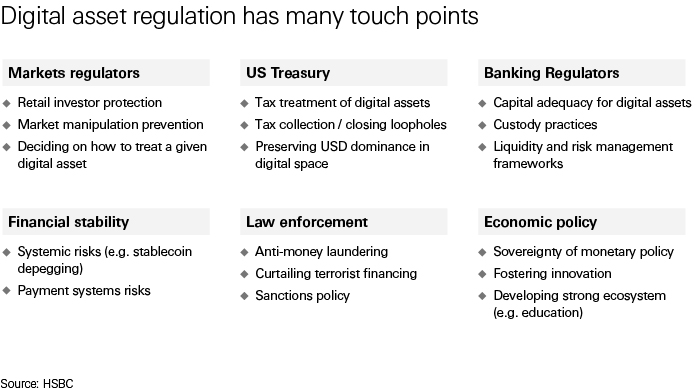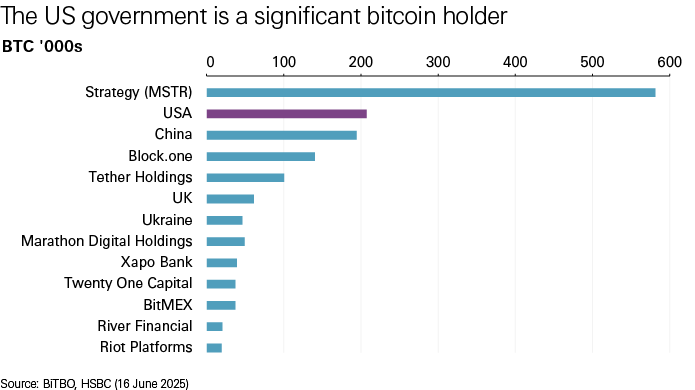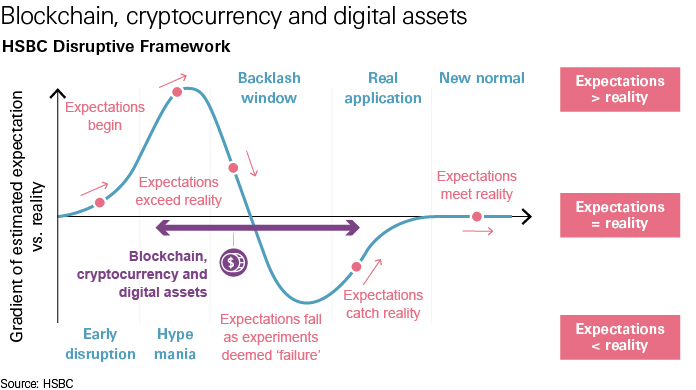- Article

- Global Research
- Digital finance
- Disruptive technology
US: The crypto tipping point - Digital assets insights
President Trump has pledged to make the US the crypto capital of the planet. What would it take to achieve this vision, and how could it affect global markets? We take a deep dive, and find that the changes already underway could turbo-charge adoption of digital assets by investors and corporations and push them into the mainstream.
The crypto capital
Plans to make the US the world’s market for crypto capital could potentially transform America’s digital asset ecosystem, prompting the next leg in wider institutional and corporate sector adoption. The US is not alone in pushing for a key place in the global digital assets marketplace. But it is well positioned to take pole position.
- Institutional investor scale: The US finance sector has the dominant investor wallet in terms of scale, and while some are already invested in digital assets, the scope for greater take-up is considerable. North America is the largest cryptocurrency market, with 22% of global activity, and is dominated (70%) by institutional money (Chainalysis).
- Digital asset innovation: The US already has a strong track record in digital asset and blockchain technology development. The existing tech sector infrastructure and associated talent pool is a further support to development.
- Venture capital support: America has a highly developed venture capital industry with a sizeable footprint of risk-tolerant capital in the digital assets ecosystem. Stripping out the distorting effect of one VC deal (MGX’s USD2bn investment in Binance) the US accounted for 39% of VC capital invested during Q1 2025 (source: Galaxy.com).
- Dollar dominance: Stablecoins, linked to fiat currencies, are likely to be a key means for institutional and corporate investors to transact in the digital space. USD-pegged stablecoins account for 99% of the overall market capitalisation for stablecoins.
- Regulatory reach and reputation: Decisions by the US regulators on how to treat a given digital asset or exchange can have a profound impact on its global valuation or business model.
- Crypto-mining dominance: Favourable regulations and cheap electricity has helped make the states of Texas and Wyoming key centres for bitcoin mining. The US is ranked number 1 in the world for its share of bitcoin mining, and accounts for 36% of activity.
Regulatory clarity is key
In designing a crypto capital, a comparison to an actual city might be pertinent. Signature buildings, jaw-dropping living spaces, and enticing shops and restaurants may get the most attention. But the success of the city will hinge more on the less glamourous aspects – making sure the sewage system works, that garbage is collected, that people feel safe, that crime is kept to a minimum. Providing an environment where the rules are clear and fair, conducive to prosperity and innovation. That is what draws people in and makes them stay.
Let’s be honest. Reports on regulation rarely rank highly on a ‘clickbait’ monitor. But if President Trump is to realise his vision of making the US into the crypto capital of the planet, a key component is to create an appropriate regulatory environment for the sector. This would foster wider adoption of digital assets by the investment community, support innovation, and also safeguard investors from malfeasance and market abuse. Sure, bitcoin maximalists may salivate over a Strategic Bitcoin Reserve, but the broader industry is likely more interested in a clear and balanced regulatory framework.
In addition, other countries are also at different stages in their strategies for regulating the digital asset sector. An aligned approach would help avoid regulatory arbitrage and foster swifter expansion of the sector.
So many (not too many) cooks
The “President’s Working Group on Digital Asset Markets” was set up in January 2025 to deliver the US regulatory framework for the issuance and operation of digital assets. Areas to address include investor protection, financial stability, tax treatment, money laundering, terrorist financing, sanctions policy, custody practises, capital requirements for banks, risk management frameworks, monetary policy sovereignty, fostering innovation, market abuse prevention, and preserving dollar relevance. A long list of topics means there is also a long list of people who will have to address them. These will include market regulators, government economic policymakers, banking regulators, law enforcement, and others as necessary.
There are a lot of cooks, but each of them has a role to play. For the US to lay claim to being the crypto capital of the world required a shift in tone, and that required a shift in personnel. This is already leading to changes in policy including, for example, the Securities and Exchange Commission (SEC) dropping some high-profile cases against the sector.
The “Escape Room”
Clarity around the rules pertaining to digital assets in financial markets carries the greatest scope to encourage or discourage adoption of digital assets by investors and corporates. The US SEC’s crypto task force (a component of the President’s Working Group on Digital Asset Markets) will be at the forefront of this aspect of digital asset regulation.
A key issue to resolve is how to create a taxonomy for digital assets, one which makes it clear who will regulate it, and therefore how stringent the regulatory requirements will be. Regulators cannot rely on constructs built around traditional finance. It is unclear whether they are ready to start afresh but it could be critical if the regulatory framework is to be fit for purpose.
In an industry such as digital assets where innovations are creating changes at pace, some patience will still be required. The framework will need to offer clarity around trading, market abuse, custody, crypto lending, crypto exchange-traded-products, tokenized securities, and possible “safe-harbour” and “sandbox” strategies among others.
Making stablecoins great(er)
Bitcoin and Ether may grab the bulk of the headlines in the financial media, but stablecoins (digital money pegged to fiat currencies or real-world commodities) are actually the dominant player in the world of digital finance. It is their “boring” lack of volatility that makes them attractive as a medium of exchange. They provide a more stable bridge between fiat and digital assets. They have the scope to transform the payments industry with cheaper and faster.
Much of the growth in this sector has been among retail investors, with institutional interest held back by regulatory considerations, including who should oversee them, and what rules should pertain to issues like reserve adequacy, money laundering/terrorist financing prevention (where stablecoins are also dominant), and custody.
The Trump administration views stablecoins as a key component of the crypto capital roadmap. Around 99% of the market capitalisation of stablecoins is pegged to the US dollar rather than other fiat currencies or commodities. The US dollar is the ‘go to’ reference for transactions in the digital space, helping to retain the fiat dollar’s reserve currency status. This is likely to galvanise efforts to set up CBDCs elsewhere, notably in the Eurozone where policymakers have already warned about the potential challenge to future monetary sovereignty from the dollar’s dominance in the stablecoin realm. It makes for an interesting future with private stablecoins and CBDCs operating in scale in the same space.
Digital “Fort Knox”
The US government now holds bitcoin and other digital assets as reserves, much like other currencies and gold for example. But the initial steps by the Trump administration to set up the US Strategic Bitcoin Reserve and a Digital Assets Stockpile were viewed as underwhelming by the market. It seems the bitcoin bulls had hoped that President Trump would signal a wave of further government-driven bitcoin purchases in the months and years ahead. Instead, it merely reassigns cryptocurrencies already held by the US government through criminal forfeiture into the reserve and stockpile. Nonetheless, while it might be dismissed as a ‘rebranding’ exercise, it is an important one as it legitimises bitcoin as a reserve asset. Many individual US states are exploring legislation to create state-level bitcoin reserves, with a handful already in play.
Internationally, a number of countries are exploring the merits of a bitcoin reserve. In addition, the executive order which established the Strategic Bitcoin Reserve also instructed the Treasury to explore strategies for acquiring further bitcoin in a budget-neutral manner. The bitcoin reserve could grow, perhaps by swapping other government assets into bitcoin (e.g. gold or the Exchange Stabilisation Fund), by the Treasury issuing bitcoin bonds, or the IRS accepting tax payments in bitcoin (however unlikely). While there was not the drama of immediate additional bitcoin purchases, they have not been ruled out.
Up for adoption
President Trump’s promise to make the US the crypto capital of the planet, whether or not you believe such a concept can even exist in the world of decentralised cryptocurrencies, comes at an interesting time for the sector. It could accelerate the adoption of cryptocurrency and blockchain technology from a niche innovation to one exhibiting mainstream use, principally by drawing in more of America’s institutional investors and corporates.
But that transition from niche to mainstream needs help. In particular, safety, simplicity and clear use cases are typically the factors that encourage adoption to move beyond only the adventurous to the majority. We explain why many aspects of the strategy to make the US the crypto capital of the planet could provide that bridge of safety, simplicity and increased use cases. As with much in the world of finance, timing is everything
Challenging the cheerleaders
The US is well placed to become the crypto capital of the world, but it faces hurdles and competition. Regulatory complexity is one such challenge. Given the multiple areas that the regulatory overhaul will impact, there are also multiple regulators involved, creating risk of turf battles or gridlocked decision making. A different form of gridlock, legislative, could also slow the pace of development, with some recent evidence of fracturing in bipartisan political support for digital asset regulatory reform. Concerns about conflicts of interest, consumer protection, and crime prevention are among the areas potentially slowing the passage of legislation through Congress. Moving digital assets from niche to mainstream will need greater buy-in from traditional finance institutions, but regulatory uncertainty, business/reputational risks around anti-money laundering (AML), crime and terrorist financing could continue to hinder adoption.
In addition, while the US was busy with its regulatory turf battles and deploying its digital asset strategy of “regulation by enforcement”, the rest of the world was moving ahead with their efforts to create policies that would position them to attract digital asset industries. Some are already further down this route of generating a cohesive industrial model that balances a business-friendly environment with the needs of consumer protection, financial stability, and crime prevention.
In Crypto We Trust
Despite these challenges, President Trump’s pledge to make the US the crypto capital of the planet is feasible. The US has a number of advantages that can help it lay claim to this title, such as the massive institutional investor base, a robust venture capital industry, a knowledgeable skill-base in the field, and the dominance of the US dollar in traditional finance and some aspects of digital finance. The new administration has also taken steps to shift the regulatory tone, installing new decision-makers into key positions. This change is already being reflected in regulatory actions. In turn, this could help the US to deliver a regulatory framework for digital assets that is fit for purpose, acting as a catalyst for wider adoption of digital assets and blockchain technology by institutional clients and corporations.
Such an outcome is far from guaranteed given the complexity of the task ahead, but it is not an impossibility. Creating a new capital city takes time, a blueprint, and people willing to build it and sustain it. Perhaps the US is where those elements will come together. If it succeeds, it could be transformative for the whole world.
Would you like to find out more? Click here to listen to an edition of The Macro Brief podcast focusing on digital assets and cryptocurrencies.
Daragh’s full report goes into further detail and includes four ‘explainers’ on blockchain, bitcoin, Ether & smart contracts, and stablecoins. Subscribers to HSBC Global Investment Research can access the full report by clicking here.
To learn more about HSBC Global Investment Research, including how to subscribe, please email us at AskResearch@hsbc.com
Navigating the AI Wave:The Future of AI in Treasury
As AI gains momentum across financial services, corporate treasury teams are under growing pressure to modernise.

The following analyst(s), who is(are) primarily responsible for this document, certifies(y) that the opinion(s), views or forecasts expressed herein accurately reflect their personal view(s) and that no part of their compensation was, is or will be directly or indirectly related to the specific recommendation(s) or views contained in this research report: Daragh Maher
This document has been issued by the Research Department of HSBC.
HSBC and its affiliates will from time to time sell to and buy from customers the securities/instruments, both equity and debt (including derivatives) of companies covered in HSBC Research on a principal or agency basis or act as a market maker or liquidity provider in the securities/instruments mentioned in this report.
Analysts, economists, and strategists are paid in part by reference to the profitability of HSBC which includes investment banking, sales & trading, and principal trading revenues.
Whether, or in what time frame, an update of this analysis will be published is not determined in advance.
For disclosures in respect of any company mentioned in this report, please see the most recently published report on that company available at www.hsbcnet.com/research.
Additional disclosures
- This report is dated as at 24 June 2025.
- All market data included in this report are dated as at close 18 June 2025, unless a different date and/or a specific time of day is indicated in the report.
- HSBC has procedures in place to identify and manage any potential conflicts of interest that arise in connection with its Research business. HSBC's analysts and its other staff who are involved in the preparation and dissemination of Research operate and have a management reporting line independent of HSBC's Investment Banking business. Information Barrier procedures are in place between the Investment Banking, Principal Trading, and Research businesses to ensure that any confidential and/or price sensitive information is handled in an appropriate manner.
- You are not permitted to use, for reference, any data in this document for the purpose of (i) determining the interest payable, or other sums due, under loan agreements or under other financial contracts or instruments, (ii) determining the price at which a financial instrument may be bought or sold or traded or redeemed, or the value of a financial instrument, and/or (iii) measuring the performance of a financial instrument or of an investment fund.
This document has been issued by HSBC Bank plc, which has based this document on information obtained from sources it believes to be reliable but which it has not independently verified. Neither HSBC Bank plc nor any member of its group companies (“HSBC”) make any guarantee, representation or warranty nor accept any responsibility or liability as to the accuracy or completeness of this document and is not responsible for errors of transmission of factual or analytical data, nor is HSBC liable for damages arising out of any person’s reliance on this information. The information and opinions contained within the report are based upon publicly available information at the time of publication, represent the present judgment of HSBC and are subject to change without notice.
This document is not and should not be construed as an offer to sell or solicitation of an offer to purchase or subscribe for any investment or other investment products mentioned in it and/or to participate in any trading strategy. It does not constitute a prospectus or other offering document. Information in this document is general and should not be construed as personal advice, given it has been prepared without taking account of the objectives, financial situation or needs of any particular investor. Accordingly, investors should, before acting on it, consider the appropriateness of the information, having regard to their objectives, financial situation and needs. If necessary, seek professional investment and tax advice.
The decision and responsibility on whether or not to purchase, subscribe or sell (as applicable) must be taken by the investor. In no event will any member of the HSBC group be liable to the recipient for any direct or indirect or any other damages of any kind arising from or in connection with reliance on any information and materials herein.
Past performance is not necessarily a guide to future performance. The value of any investment or income may go down as well as up and you may not get back the full amount invested. Where an investment is denominated in a currency other than the local currency of the recipient of the research report, changes in the exchange rates may have an adverse effect on the value, price or income of that investment. In case of investments for which there is no recognised market it may be difficult for investors to sell their investments or to obtain reliable information about its value or the extent of the risk to which it is exposed. Some of the statements contained in this document may be considered forward looking statements which provide current expectations or forecasts of future events. Such forward looking statements are not guarantees of future performance or events and involve risks and uncertainties. Actual results may differ materially from those described in such forward-looking statements as a result of various factors.
This document is for information purposes only and may not be redistributed or passed on, directly or indirectly, to any other person, in whole or in part, for any purpose. The distribution of this document in other jurisdictions may be restricted by law, and persons into whose possession this document comes should inform themselves about, and observe, any such restrictions. By accepting this report, you agree to be bound by the foregoing instructions. If this report is received by a customer of an affiliate of HSBC, its provision to the recipient is subject to the terms of business in place between the recipient and such affiliate. The document is intended to be distributed in its entirety. Unless governing law permits otherwise, you must contact a HSBC Group member in your home jurisdiction if you wish to use HSBC Group services in effecting a transaction in any investment mentioned in this document.
Certain investment products mentioned in this document may not be eligible for sale in some states or countries, and they may not be suitable for all types of investors. Investors should consult with their HSBC representative regarding the suitability of the investment products mentioned in this document.
HSBC and/or its officers, directors and employees may have positions in any securities in companies mentioned in this document. HSBC may act as market maker or may have assumed an underwriting commitment in the securities of companies discussed in this document (or in related investments), may sell or buy securities and may also perform or seek to perform investment banking or underwriting services for or relating to those companies and may also be represented on the supervisory board or any other committee of those companies.
From time to time research analysts conduct site visits of covered issuers. HSBC policies prohibit research analysts from accepting payment or reimbursement for travel expenses from the issuer for such visits.
HSBC Bank plc is registered in England No 14259, is authorised by the Prudential Regulation Authority and regulated by the Financial Conduct Authority and the Prudential Regulation Authority and is a member of the London Stock Exchange. (070905)
© Copyright 2025, HSBC Bank plc, ALL RIGHTS RESERVED. No part of this publication may be reproduced, stored in a retrieval system, or transmitted, on any form or by any means, electronic, mechanical, photocopying, recording, or otherwise, without the prior written permission of insert issuing entity name.






